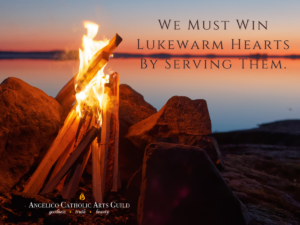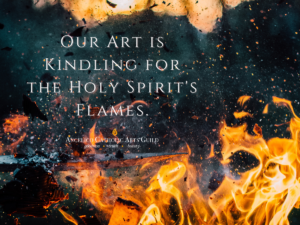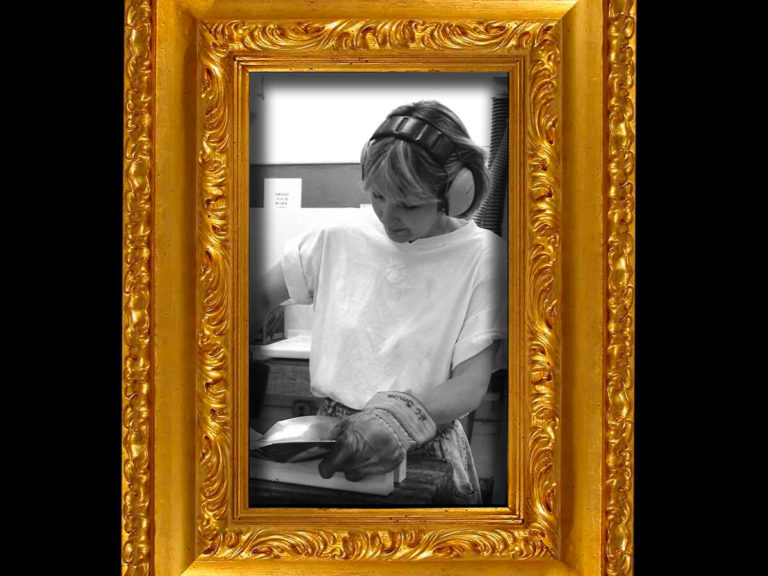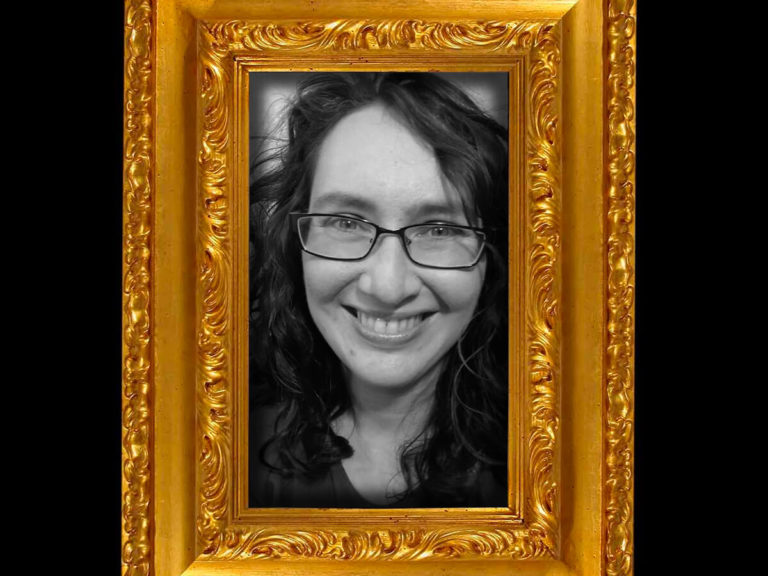 “No one, after lighting a lamp, hides it under a jar, or puts it under a bed, but puts it on a lampstand, so that all who enter may see the light.”
“No one, after lighting a lamp, hides it under a jar, or puts it under a bed, but puts it on a lampstand, so that all who enter may see the light.”
–Luke 8:16
The Church’s destiny is to shine.
From ages past, reaching through the centuries to her founding by Christ Himself, the Catholic Church has been the shining city on a hill, a beacon for the world to see. She gets her light from the Spirit’s life within its members–within you and me.
But is your light in hiding?
The Church will always be the city on a hill, but she’s shining less and less these days. Too many of us burn lukewarm and dim. Others conceal the Spirit’s fire beneath isolation, timidness, or pride.
As the Angelico Catholic Arts Guild’s earliest members, you’re fired up and ready to ignite the world for Christ. Lukewarmness isn’t a problem. You know the world needs the Church. You know the critical damage the Church is taking. We’re losing our own by the thousands, and the only thing that can save them is the Spirit’s light burning…in you.
While all Catholics are called to uncover their lamps and spread their fire, Catholic artists have a third mission. We’re here to make the fuel that keeps the fire burning. To inspire faith with our stanzas, sculptures, and songs. Our works are the kindling, oil, wicks, and wax that feed the Church’s flames. But they’re only effective if we don’t isolate ourselves, steal the glory, or shy away.
The good news is that we have a guide in our efforts to evangelize the Church with art. All we need to do is follow St. Louis de Montfort.

How to Win Friends and Influence People, Catholic Artist Edition
Rome wasn’t built in a day, but Calvary was built in a year–or at least St. Louis de Montfort’s was. Though he’s best known today for his Marian writings, rural France knew him as “the oddball priest” who dreamed of a larger-than-life Calvary scene that would spark a nation’s faith.
A Calvary scene built in the French countryside was a pipe dream, but Louis had the spunk to get it done. St. Louis de Montfort was a bulldog for Christ. He was doggedly determined, fiery in his preaching, fierce in his devotion, and built like an ox. He’s even rumored to have started a few brawls when someone insulted Jesus or Mary–not the best approach, but it sure got people talking! He was too passionate, his fire too bright, for the sparks that flew from his faith not to ignite and start new flames.
If we want our city on a hill to shine as it was meant to shine–if we want to rekindle the Church and set the world ablaze–there are worse shoes to walk in than St. Louis de Montfort’s. His life is a Catholic artist’s roadmap, and we can save the Church one soul at a time if we follow where it leads..
Evangelizing Mainstream Catholic Culture by Entering It
Pontchateau, France was hardly a center of Catholic devotion in St. Louis de Montfort’s day. It was sparsely-populated, oft-overlooked, and lacked religious and resources. Its priests were overworked from shepherding multiple parishes while city parishes had plenty on hand.
Building a religious monument in rural France, where priests were scarce and faith scarcer yet, made as much sense as putting one in a cornfield. But Louis lived for places like this. He never set out to serve the devout or comfortable. His passion was for the poor, the downtrodden–people whose lives held more darkness than light. He knew the Spirit’s fire in his heart did these poor souls no good unless he brought it into their midst.
So that’s what he did.
When Louis de Montfort entered a town, it was never the same. Maybe it was because his first stops were at hospitals or prisons. Maybe it was because watching him spend hours on his knees in Adoration was a novelty few had seen. Maybe it was his poverty, his tattered clothes. The fact that he begged for his food the same way their lowest citizens did. Or that any money he was given, he gave to someone else. Most likely, it was a combination of these.
Louis lived his faith out loud in mainstream Catholic culture. In a lukewarm France, he refused to cling to the center. Instead, he sought the margins–and he didn’t let the culture change him. He was a rebel, an eccentric, and his presence worked inescapable questions in people’s hearts. No doubt about it, Catholics who witnessed his ways were curious about Louis de Montfort. So when he said he needed help with his Calvary?
They were curious enough to say yes.
But that was just the start of Louis’ plans.

Winning Lukewarm Hearts by Serving Them
St. Louis de Montfort’s Calvary project was unlike other monument constructions–and not just by scale or subject matter, though these were impressive enough. You might even be tempted to label Louis attention-seeking, so grandiose was his scheme. A living rosary circle of 165 trees? Statues, chapels, and grottos in a sprawling Passion tableau? A towering Cross that made it clear for miles around in whose name this land had been claimed? Who was he trying to impress?
The better question is what was he trying to impress–and upon whom.
Louis’ Calvary wasn’t about beauty wrought by human hands. It was about beauty wrought in human hearts. Each evening as the sun sank low, Louis’ volunteer army quit their labors–but they didn’t leave. With aching backs and feet, with arms they could barely lift, the men trudged to the grotto housing the statues. And there they would pray.
After a day’s labor that made it impossible to forget the Cross, they stopped to remember the Cross once more.
Louis did more than shed light over these men. Somewhere between his example, his idea, and recreating Calvary, the light from Louis’ lamp set their own hearts ablaze. And that had been the plan all along.
The Calvary at Pontchateau was never about Louis himself. It was about the poor and forgotten of rural France. He wasn’t an artist. He was a servant. He fed the poor, visited the sick, and built Calvary for those with a faith gone lame. His art was a way to be at the joyful, bold, attentive service of the people Christ came to save.
It takes a supernatural love to sacrifice yourself like St. Louis de Montfort. How did he do it? What gave him the strength? It came from the usual source–from Christ Himself. Specifically, it came from knowing who he was through the lens of Jesus.

Changing the World by Staying True to His Identity in Christ
In just over a year, Louis’ faith had moved mountains–or built one outside an unassuming town in Brittany. It was meant to be a monument for the ages, the Holy Land of western France. Alas. Such was not to be.
Days before the bishop was to bless the Calvary, the government got involved. Louis’ adversaries had informed authorities that the monument was meant to hide English soldiers. The best course, the government decided, was to demand that Calvary be destroyed–by the men who’d built it with their own hands.
The grief must have been excruciating. Blood, sweat, tears, heart, and soul had gone into this work. Louis was well-known for his short fuse, and this was sure to set him off.
Or so you might think.
On the would-be blessing day, a crowd of thousands gathered at the Calvary. The bishop never came. Only Louis addressed the throng. “We had hoped to build a Calvary here,” he said simply. “Let us build it in our hearts. Praise God.”
Calvary was never about man’s glory. And Louis’ Calvary was no vain tribute to his genius. Its purpose was solely to bring and keep people in Christ’s light. With complete docility to God’s will, Louis accepted that his art was kindling. His monument was burned away so Calvary could burn in faithful hearts instead.
Free of pride and pretense, Louis knew who he was. He was God’s instrument. Nothing more…but nothing less. If Louis wanted to evangelize the Church, he had to make art…but he also had to let go of the art he made.
Fortunately, he did. He let go. Moved on. He created new art–new buildings, new sculptures, new writings. And through those writings–possible because he accepted that his work was kindling–a young Polish man fell in love with Mary, became Pope, and unleashed Calvary on the world.
A 3-Step Fire Starter for Catholic Artists
From writers to dancers to graphic designers, we are artists and we are Catholics–and that means we are art evangelists. Most of us won’t build a massive Calvary outside the city limits, but every Catholic artist is called to uncover his lamp, spread his fire, and add fuel to the blaze. These three steps are the secret to building a fire that will burn to Kingdom come.
And given the state of the Church these days, it’s long past time to start.
Uncover Your Lamp
Beauty will save the world. It’s the Catholic artist’s rallying cry. As one of these artists, you’re ready to save the world with beauty…but where are you willing to go?
Rural France? Communist China? To the land of drug cartels?
How about your average American parish?
We know the world needs the Church, but what does the Church need? Holiness. It needs role models where the lukewarm and heterodox congregate. Will you shine your light in the dark spaces where the lukewarm await the Spirit’s flame?
It’s tempting for devout Catholics to cling to each other, but does that uncover our lamps? Or does it just bring other lights into hiding with ours? Yes, we need fellowship with faithful Catholics, but that can’t be the end. How much have we unwittingly covered our lamps?
Do we attend small groups with lifelong Catholics ignorant of Church teaching? Enjoy fellowship with parishioners who don’t value Adoration? Do we attend Mass at a parish whose priest longs to ignite his people’s faith, but who doesn’t have enough “good” Catholics to set an example–because they all attend the devout parish down the way?
The man behind France’s Calvary was an architect, painter, writer, and sculptor, but most of all, he was present to the people he aimed to change. He inspired the farmers in and around Pontchateau to take up his crazy scheme and the faith that inspired it. He set rural France on fire, but only because he refused to hole up in a Catholic haven, ministering to those who already had faith.
He was there. In the dark. Lamp uncovered. Showing others the way. Let’s follow in St. Louis de Montfort’s footsteps. Let’s step into mainstream Catholic culture and watch hearts and lives change.

Spread Your Fire
St. Louis de Montfort had a servant’s heart. What does a servant’s heart look like? It looks like a campfire, actually. Warm, strong, and focused in a central place, a campfire draws everyone into the glow of its flames.
The biggest draw of a campfire is its warmth–particularly in a dark, chill place. We talk about the Spirit’s fire, but often, our artistic “service” runs cold. We look more to our grievances than to the people we serve. The congregation won’t sing the parts of the Mass! Doesn’t anyone care that this is the Eucharist? Why do we work so hard if no one’s going to participate?
We say these things all the time, don’t we? It’s easy to get frustrated, but no one will want to come close enough to catch our fire if we act like we’re made of ice. The Bible tells us that God loves a cheerful giver. He desires joyful servants–servants like St. Louis de Montfort.
What if, instead of griping, we focused on the people who need us? Why won’t the congregation sing? Let’s find out. How can I help them follow along? Adjusting our art to meet actual, not perceived, needs requires an observant heart. When we love someone, we pay attention to them. And what’s evangelization without love?
St. Louis de Montfort loved his people enough to pay attention to their needs–and to act boldly. There was nothing timid about his Calvary. Timid strikes don’t spark a flame. To make sparks, you strike firmly, not with half-hearted force, too afraid of getting burned to give it all your strength.
Warmth and joy. Attention built on love. Boldness and strength. That’s how we build the campfire of evangelization. That’s how an uncovered lamp spreads its flames. Are you ready to spread yours?
Be bold. Make a plan. Enact it with joy. The lukewarm are waiting to catch your flame.
Add Fuel to the Blaze
You can uncover your lamp and spread your fire all you want, but without fuel, that blaze won’t burn for long. How do you keep it burning? What sort of fuel do you make? Do you make art–or does your fire run on vanity?
Ecclesiastes tells us that all things are vanity. Unfortunately, we know all about that. Artistic pride–that possessive passion for glory, acclaim, or control of our work–is a monster that stalks every artist. As people whose work falls into the public eye–and as fallen human beings–we’re easy prey.
But we’re not alone! Even St. Louis de Montfort wasn’t immune to vanity. In a letter discussing his good works, Louis wrote:
“This is why I am so highly praised by nearly everyone in town, which, incidentally, can be a very great danger for my own salvation.”
St. Louis de Montfort knew he needed to keep his ego in check. His salvation depended on it–and so did his power to fuel other’s faith.
As artists, we spend a lot of time, care, and effort on our craft. It helps us do better work, but it can also lead to snobbery, an artistic pride that makes us look down on “lesser” achievements. In turn, we may reject projects that benefit our fellow Catholics just because they offend our artistic sensibilities. Worse, we may agree to help, but end up taking over, showing off as we belittle everyone else.
We’d like to think we’re immune to such boorish behavior, but it’s too great a danger to ignore. Be vigilant! Cultivate humility. True art is unpretentious. True art fuels the Church’s blaze. Art that elevates our self-importance, on the other hand, leaves us cold, putting out our flames.
Forget about changing the world. Let Christ change the world through you–through you and the art you make. Then you’ll be working for His glory, not your own–just like St. Louis de Montfort did.

This Little Light of Mine
Somewhere in the Church’s darkest corner, a wayward or lukewarm Catholic’s light is flickering. But you have the power to set it ablaze.
On Easter Vigil, each of us receives a candle–fuel that can feed a flame. It’s a humble candle. Slender, brittle, circled with a cheap paper disc. But when it’s lit by the Easter fire and held aloft, everyone can see its light. And if you use it to ignite the wicks around you? Pretty soon, the sanctuary gleams with a hundred flames.
In our pandemic times, most of us were deprived of candles for the Easter Vigil flame. But no pandemic can put out the faithful’s light. Only we can do that–by refusing to uncover our lamps and spread the flame.
Candles aren’t a problem. You know what you long to make. St. Louis de Montfort’s dream was a Calvary. Maybe yours is a song.
But evangelization, even through the arts, is about more than the means. It’s about our attitudes, our openness, our hearts. It’s about rejecting isolation, uncovering our lamps, and stepping into the dark. It’s about refusing to be timid, about paying attention, reaching out with joy, and boldly lighting someone else’s flame. And yes, it’s about making art–making the candles that fuel the flame…but doing so without an ounce of pride. It’s about replacing pride and pretense with humility and faith. It’s about remembering that when all is said and done, our work is but a slender, brittle candle with a paper disc. But it’s exactly what God needs.
A single candle. A humble, bold, artist standing in the dark. But with that one light, the entire city on the hill will shine.



